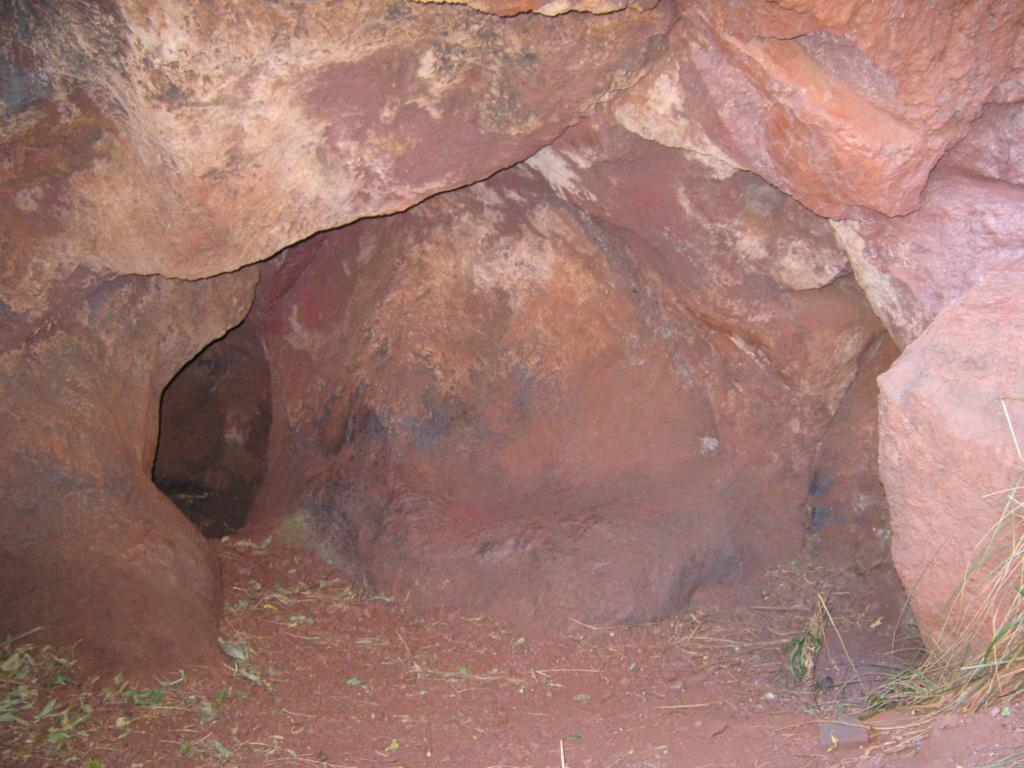Ngwenya Mountain has the world's oldest
known mine, the Lion Cavern, where, around 41 000 BC, Hematite was
mined for cosmetic and ritual uses. This ancient mine is located
next to the modern open cast iron ore mine. Iron ore mining is
mainly found on the Ngwenya mountain massif. It
contains deposits of high grade iron ore which have been worked
continuously for the past 50 000 years.

The archaeologist, Peter Beaumont, produced
evidence of mining in the middle Stone Age, later Stone Age and
Iron Age. At Ngwenya, Middle Stone Age man tunnelled into the precipitous western face in search of
iron pigments, the weathered ochreous forms
of Hematite (libomvu) near the surface, and the harder
black glistening form of the ore called specularite (ludumare). In
1967 charcoal nodules from some of the more ancient tunnels were
sent to both Yale and Groningen radiocarbon
laboratories where Carbon 14 testing was carried out on it. A date
of about 43 000 BC or 41 000 BC was obtained, making this the
oldest known mining operation in the world. It is thought these
ores were mined until at least 23 000 BC. At Lion Cavern it is
estimated that at least 1 200 tons of soft hematite ore, rich in
specularite, had been removed in ancient
times.

“Lion Caven” is situated in
the Malolotja Nature Reserve. The geology of
Malolotja is very diverse and includes
some granites (Lochiel Granite, estimated to be
about 3 000 million years old), but is predominantly made up of
metamorphosed sedimentary rock formations of the Barberton Mountains, including the Onverwacht, Fig Tree and Moodies series
of rocks. These rocks are thought to be about 3500 million years
old, and are thought to contain fossils of the earth's oldest life
forms - blue-green algae (see EarthCache
GC1Y2R7). It is in these mountains that
the ironstones, talc schists and other metal bearing
rocks are found, where the various mining activities have been
carried out over the last hundred years.
Malolotja is situated on the great
southern African escarpment where it embraces the ecotone between the highveld and
middleveld. Ironstones and quartzites are common and, because of their greater
resistance to erosion, give rise to the rugged relief of the region
and stand up as high mountain ranges and peaks. The best examples
include Ngwenya Mountain, Silotfwane Mountain and the Mgwayiza Range. The more gentle undulating hills and
slopes are composed of softer rocks such as soapstones. This has
given rise to landscapes such as the upper Malolotja and Majolomba
river valleys and the Malolotja Vlei. Younger rocks, such as the granites, are found
along the eastern border of the reserve. Some of the granite
formations are crossed by dolerite dykes
and these are also resistant to erosion. The most prominent of
these formations would include the big boulders near the log
cabins, the Majolomba Picnic Site and
Tjomoloti Hill just below the Nkomati Viewpoint. Outside the reserve boundary,
overlooking the Malanti valley, is an almost
vertical exposed face of rock made up entirely of granite. This
magnificent feature can be seen from the Nkomati Viewpoint road inside the reserve.
Acknowledgments:
Internet link http://www.sntc.org.sz/cultural/ironmine.html
Jan 4, 1930. The SA Mining and Engineering Journal.
Dec 28 1929. The SA Mining and Engineering Journal.
Feb 1988, John R Masson. Mining at Ngwenya - both Ancient and Modern, Causes and
Effect.
To get credit for a find on this EarthCache
you need to answer the following questions in a mail to the cache
owner.
- If you use the metal stairs leading down to the Lion
Caven, you will find a Info board just before you enter
the Lion Caven. What “People” are
revered to in line two on this sign?
- Please indicate in the mail to the cache owner; how many steps
leads up on the stairs from the hiking trail to the viewpoint?
- Please indicate in the mail to the cache owner; how many steps
leads down on the stairs from the viewpoint to the Lion
Caven?
- Estimate the height and width of the ancient mine on the left
when you enter the Lion Caven?
- Describe the rocks at the viewpoint, and if you can notice
“rusting” of the iron in the rocks taking place?
(ie colour, grain size)
- Optional you can take a picture at the viewpoint with the Iron
ore mine visible and attach the photos in your log.